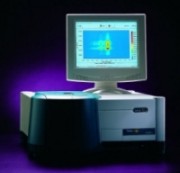
The Cary Eclipse (Agilent Technologies) is a computer-controlled fluorescence spectrophotometer with measurement modes for fluorescence, chemiluminescence, bioluminescence , and time-resolved phosphorescence. The Eclipse offers many useful components: a full-spectrum Xe pulsed lamp source (80 Hz, pulse width at half-peak height = 2 µs, peak power equivalent to 75 kW), horizontal beam geometry, Czerny-Turner monochromators with 12.5 cm focal width, fixed selective SWE from 1.5‒20 nm, and an all-refractive collection system with quartz overcoated optics.
Detection capabilities include a wavelength range of 190‒900 nm wavelength, scan rate of 0.01‒24,000 nm/min, maximum measurement rate of 80 data points/sec in fluorescence mode, non-measurement phase-stepping wavelength drive, and room light immunity in fluorescence mode.
The instrument is also equipped with (a) Peltier temperature-controlled cuvette holder TLC 50 (Quantum Northwest) with magnetic stirring and four open windows for fluorescence, (b) automated vertical and horizontal polarizers which automatically move out of the optical path when not in use, and (c) a custom-built accessory for time-resolved luminescence measurement.
Selected publications of instrument use:
- Guhathakurta, P, E Prochniewicz, O Roopnarine, JA Rohde, and DD Thomas. 2017. A cardiomyopathy mutation in the myosin essential light chain alters actomyosin structure. Biophys J 113:91-100.
- Guhathakurta, P, E Prochniewicz, and DD Thomas. 2015. The amplitude of the actomyosin power stroke depends strongly on the isoform of the myosin essential light chain. Proc Natl Acad Sci U S A 112:4660-4665.
Acknowledgements
The BTC should be acknowledged in any publications arising from the data analyzed in the BTC with the following text:
Experiments reported in this paper were performed at the Biophysical Technology Center, University of Minnesota Department of Biochemistry, Molecular Biology, and Biophysics.
Once published, please let us know via an email to umn-btc@umn.edu.